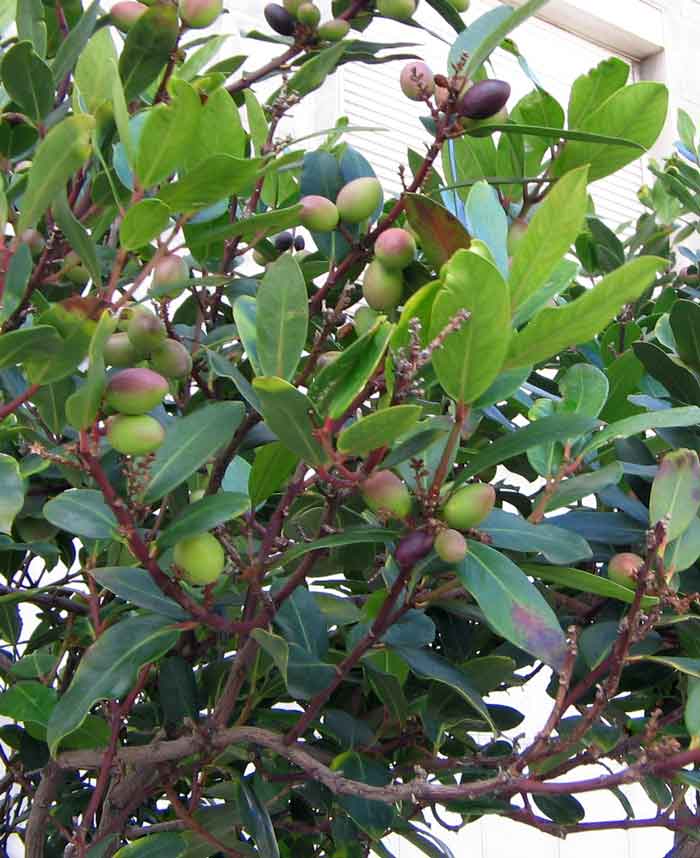
Persea indica (*)
Classification System: APG IV
Superregnum: Eukaryota
Regnum: Plantae
Cladus: Angiosperms
Cladus: Magnoliids
Ordo: Laurales
Familia: Lauraceae
Tribus: Cinnamomeae
Genus: Persea
Species: Persea indica
Name
Persea indica (L.) Spreng., 1825
Synonyms
Borbonia indica (L.) J.Presl
Laurus americana Nees
Laurus indica L.
Laurus latifolia Salisb.
Laurus teneriffae Poir.
Ocotea indica (L.) Kostel.
Persea pseudoindica Link
Persea teneriffae F.Muell.
Phoebe indica (L.) Pax
Distribution
Native distribution areas:
Continental: Africa
Regional:Macaronesia
Canary Is., Madeira
Introduced into:
Azores
References: Brummitt, R.K. 2001. TDWG – World Geographical Scheme for Recording Plant Distributions, 2nd Edition
References
Primary references
Sprengel, C. 1825. Caroli Linnaei, ... Systema vegetabilium. Ed. 16. Vol. II: Classis 6–15. 939 pp. Sumtibus Librariae Dieterichianae, Gottingae [Göttingen]. BHL Reference page: : 2:268.
Additional references
Dobignard, A. & Chatelain, C. 2012. Index synonymique de la flore d'Afrique du Nord. Volume 4: Dicotyledoneae: Fabaceae – Nymphaeaceae. Conservatoire et jardin botaniques, Genève, ISBN 978-2-8277-0126-1, 431 pp. PDF Reference page.
Links
Govaerts, R. et al. 2022. Persea indica in Kew Science Plants of the World online. The Board of Trustees of the Royal Botanic Gardens, Kew. Published online. Accessed: 2022 June 26. Reference page.
Hassler, M. 2022. Persea indica. World Plants: Synonymic Checklists of the Vascular Plants of the World In: Roskovh, Y., Abucay, L., Orrell, T., Nicolson, D., Bailly, N., Kirk, P., Bourgoin, T., DeWalt, R.E., Decock, W., De Wever, A., Nieukerken, E. van, Zarucchi, J. & Penev, L., eds. 2022. Species 2000 & ITIS Catalogue of Life. Published online. Accessed: 2022 June 26. Reference page.
International Plant Names Index. 2022. Persea indica. Published online. Accessed: June 26 2022.
USDA, ARS, Germplasm Resources Information Network. Persea indica in the Germplasm Resources Information Network (GRIN), U.S. Department of Agriculture Agricultural Research Service. Accessed: 07-Oct-06.
Vernacular names
العربية: برساء هندية
беларуская: Индийска персея
čeština: hruškovec indický
Deutsch: Indische Persea
Esperanto: Makaronezia perseo
español: Viñatigo
فارسی: برساء هنديه
suomi: Makaronesianavokado, madeiranavokado
português: Vinhático
русский: Персея индийская
Persea indica is a species of plant in the family Lauraceae. It belongs to the evergreen tree genus Persea of about 150 species, of which the avocado, P. americana, is the best known.
It is native to Madeira and the Canary Islands and introduced in the Azores in Macaronesia.[1] It is threatened by habitat loss. It is the vegetable symbol of the island of La Gomera.[2]
Overview
This article needs additional citations for verification. Please help improve this article by adding citations to reliable sources. Unsourced material may be challenged and removed.
Find sources: "Persea indica" – news · newspapers · books · scholar · JSTOR (August 2015) (Learn how and when to remove this template message)
The family Lauraceae was part of Gondwanaland flora. There they spread over most of the continent. The genus Persea died out in increasingly xerophytic Africa, starting with the freezing of Antarctica about 20 million years ago and the formation of the Benguela current. The genus is extinct in Africa, save for P. indica, which survives in the fog shrouded mountains of the Canary Islands, which with Madagascar, constitute Africa's Laurel forest plant refugia.
Fossil evidence indicates that the genus originated in West Africa during the Paleocene, and spread to Asia, to South America, and to Europe and thence to North America. It is thought that the gradual drying of Africa, west Asia, and the Mediterranean from the Oligocene to the Pleistocene, and the glaciation of Europe during the Pleistocene, caused the extinction of the genus across these regions, resulting in the present distribution.
Persea indica is a species exclusive to Laurisilva, since this habitat is constantly threatened by encroaching agriculture, the laurel forest animal or vegetal species had already become rare in many of its former habitats and are threatened by habitat loss.
Fossil record
Fossils of Persea indica have been described from the fossil flora of Kızılcahamam district in Turkey, which is of early Pliocene age.[3]
See also
List of animal and plant symbols of the Canary Islands
References
Fernandes, F.; da Silva Menezes de Sequeira, M.P. (2017). "Persea indica". IUCN Red List of Threatened Species. 2017: e.T30329A102153566. doi:10.2305/IUCN.UK.2017-3.RLTS.T30329A102153566.en. Retrieved 15 November 2021.
"Símbolos de la naturaleza para las Islas Canarias" [Natural Symbols for the Canary Islands]. Ley No. 7/1991 of 30 April 1991 (in Spanish). Vol. 151. pp. 20946–20497 – via BOE.
Kasaplıgil, Baki (1977). "Ankara, Kızılcahamam yakınındaki Güvem köyü civarında bulunan son tersiyer kozalaklı-yeşil yapraklı ormanı" [A Late-Tertiary Conifer-Hardwood Forest From the Vicinity of Güvem Village, Near Kızılcahamam, Ankara] (PDF). Bulletin of the Mineral Research and Exploration (in Turkish and English). Ankara: General Directorate of Mineral Research and Exploration. 88: 94-102.
Retrieved from "http://en.wikipedia.org/"
All text is available under the terms of the GNU Free Documentation License

